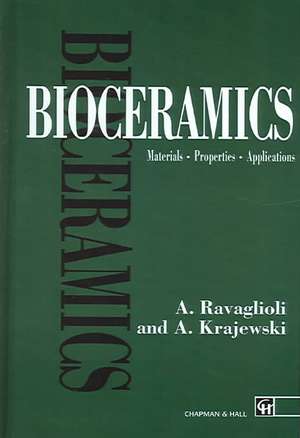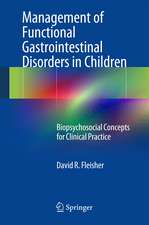Bioceramics: Materials · Properties · Applications
Autor A. Ravaglioli, A. Krajewskien Limba Engleză Hardback – 31 dec 1991
| Toate formatele și edițiile | Preț | Express |
|---|---|---|
| Paperback (1) | 1223.74 lei 6-8 săpt. | |
| SPRINGER NETHERLANDS – 17 sep 2012 | 1223.74 lei 6-8 săpt. | |
| Hardback (1) | 1229.91 lei 6-8 săpt. | |
| SPRINGER NETHERLANDS – 31 dec 1991 | 1229.91 lei 6-8 săpt. |
Preț: 1229.91 lei
Preț vechi: 1499.88 lei
-18% Nou
Puncte Express: 1845
Preț estimativ în valută:
235.34€ • 246.38$ • 194.73£
235.34€ • 246.38$ • 194.73£
Carte tipărită la comandă
Livrare economică 07-21 aprilie
Preluare comenzi: 021 569.72.76
Specificații
ISBN-13: 9780412349607
ISBN-10: 0412349604
Pagini: 422
Ilustrații: XV, 422 p.
Dimensiuni: 155 x 235 x 25 mm
Greutate: 0.79 kg
Ediția:1992
Editura: SPRINGER NETHERLANDS
Colecția Springer
Locul publicării:Dordrecht, Netherlands
ISBN-10: 0412349604
Pagini: 422
Ilustrații: XV, 422 p.
Dimensiuni: 155 x 235 x 25 mm
Greutate: 0.79 kg
Ediția:1992
Editura: SPRINGER NETHERLANDS
Colecția Springer
Locul publicării:Dordrecht, Netherlands
Public țintă
ResearchCuprins
1 A historical and philosophical outline and prospects for the application of biomaterials.- 1.1 Historical survey.- 1.2 Social and philosophical reasons for the interest in this sector.- 1.3 Problems in replacing parts of the human body.- 1.4 Prospects for skeletal substitution.- 1.5 Attempts at bone reconstruction by using bioactive ceramics.- 1.6 Application of bioceramics to plastic surgery.- 2 Physical properties and physiology of bone.- 2.1 The nature of bone.- 2.2 Physiology of bone.- 2.3 Ordinary bone remodelling and bone restoring mechanisms.- 2.4 Bone transplantation.- 2.5 Specific physical properties of bone.- 2.6 Mechanical resistance of bone.- 2.7 Viscoelastic behaviour of bone.- 2.8 Piezoelectricity of bone.- 2.9 Materials and piezoelectric stimulation.- 2.10 Supposed thermoluminescent activity of bone.- 2.11 Characteristics of the composition of bone.- 3 Survey of the physics of the locomotion of the human body.- 3.1 General.- 3.2 A study of stress distribution on some important joints of the human body.- 4 General problems connected with the use of biomaterials.- 4.1 Fixing methods.- 4.2 Comments on the experience acquired of the response of ceramics currently used in orthopaedics.- 4.3 The problem of wear: mechanisms and recent developments.- 5 Compatibility between bioceramics and the physiological environment.- 5.1 Introduction.- 5.2 Hostility of the biological environment.- 5.3 Ceramic/tissue interface.- 5.4 Tissue responses.- 5.5 Problems in determining the compatibility of biomaterials.- 5.6 Encapsulation of implants.- 5.7 Some physical factors influencing the acceptance of synthetic materials as tissue implants.- 5.8 Some evaluations of the biological fitness of bioactive ceramic materials.- 5.9 The role of debris.- 5.10 Thrombogenic dangers of materials in contact with blood.- 5.11 Treatment of the surface of ceramics by coating of prostheses.- 5.12 Proposal for an indirect investigation based on the thermal properties of bone.- 6 Materials for surgical use.- 6.1 Introduction.- 6.2 General discussion of various biomaterials.- 6.3 Ceramics.- 7 Glasses and ceramics as coatings for massive supports.- 7.1 The metallic support.- 7.2 Techniques for application of ceramic or glassy coating to metals.- 7.3 Metal/glass interface.- 7.4 Plasma spraying.- 7.5 Other crystalline coating materials as substitutes for Al2O3.- 7.6 Technique of measurement of the mechanic stresses on coatings.- 8 Shape and mechanical resistance.- 8.1 Survey of physico-mechanical behaviour.- 8.2 Main manufacturing methods.- 8.3 Mechanical design in ceramics.- 8.4 The shaping project.- 9 Range of application of ceramic prostheses for surgical implants.- 9.1 Knee joint replacement.- 9.2 Substitution in the hip region.- 9.3 Bulk alumina.- 9.4 Cardovascular materials and implants.- 10 Current mechanical-testing devices as simulators of properties under dynamic movement.- 10.1 General principles.- 10.2 Analysis of the forces and movements involved at the human hip and at the knee joint.- 10.3 Types of equipment for tribological investigation.- 10.4 Joint simulator.- 10.5 Assessment of roughness.- 10.6 Assessment of breaking load.- 10.7 Hardness tests.- 10.8 Fatigue tests by cycling-load simulator devices.- 10.9 Radiotelemetric devices for the evaluation of the clinical course of implants and sutures.- 11 Maxillofacial implants.- 11.1 Dental implants.- 11.2 Ear prostheses.- 11.3 Fillers.- 12 Fixing of the prosthesis to the skeletal part.- 12.1 Mechanical locking.- 12.2 Biological interlocking.- 12.3 Implant/bone-tissue interface.- 13 Approach to biocompatibility tests.- 13.1 Compatibility tests in general.- 13.2 Evaluation of specific biological compatibilities.- 13.3 Attempts at eliminating bacterial infection.- 14 International standardization of measurement procedures.- 14.1 Generalities.- 14.2 Classification criteria for the organization of standardized tests.- 14.3 Critical discussion of biocompatibility tests.- 14.4 Methods of evaluation of the bone/prosthesis interface.- 14.5 Introduction to the tests for the mechanical characterization of biomaterials.- 14.6 Standardization of the dimensions of sample prostheses.- 14.7 An example of standardized evaluation of the performance of a material: the case of Al2O3.- 14.8 Microstructure.- 14.9 Behaviour of a material under wear.- 14.10 Tests to evaluate the corrosion of a product under fatigue.- 14.11 Mechanical strength.- 14.12 Compressive strength.- 14.13 Bending tests.- 14.14 Measurement of elastic and anelastic deformation.- 14.15 Electro-acoustic instruments used to measure elastic modulus and internal friction.- 14.16 Measurement of internal friction.- 14.17 Resistance to chemical corrosion.- 14.18 Microhardness.- 14.19 Aspects of the qualitative testing of some ceramic manufactures of biomedical use.- 14.20 Problems relative to the thermal expansion coefficient.- 14.21 Thermal expansion of glasses.- 14.22 Progress report on the regulation governing the bioceramics for prosthetic uses.- 14.23 A few words on the regulation governing the biological acceptability of materials manufactured into products.- Appendix A.- Appendix B.- Appendix C.












